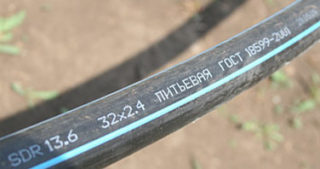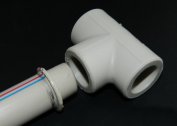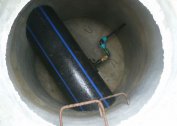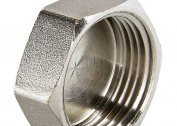If you want to relax in the country with comfort, you need to bring a water main to the summer house. The best option is a water supply system made of plastic pipes. Construction equipment will not devastate the family budget, and even a layman can do the installation with his own hands. The main thing is to choose the right materials, draw up a project and follow the technological instructions.
Technical characteristics of HDPE pipes
To create an aquifer, low-pressure polyethylene pipes (HDPE) are used. High pressure polymers (LDPE) are used only in small areas requiring bending resistance.
When choosing parts for a future communication network, focus on their color. Elements suitable for drinking water are needed. They are black with a bluish or white stripe. You should also check the information on the section, wall thickness and GOST number. All this is indicated on the surface of the product.
A letter is indicated on the pipe indicating working pressure. A suitable option would be a product with the letter T, withstanding more than 10 atmospheres. According to the state standard, the diameter of water pipes starts from 3.2 cm. The length of the product is 240 cm.
Pipes are selected in accordance with the water pressure in the system, the length of the water supply, as well as the total number of connections and turns. For a small country house, you can take elements with a diameter of 25 mm, for a large one, you should choose four-centimeter pipes.
In addition to pipes, to create a communication highway at the summer cottage you will need:
- connecting and adapter couplings and fittings;
- tees for wiring;
- flanges for connection to a spillway;
- plugs for shutting off water for the winter.
They are especially carefully selected for the selection of these parts, because the tightness of the communication line depends on them.
Advantages and disadvantages of plastic pipes
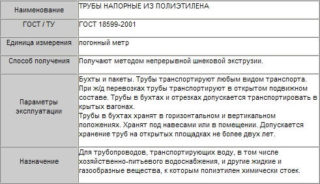 The main advantages of such products are the budget cost and ease of installation. For assembly, you do not need a specialized tool - all connecting parts are already threaded. It is only necessary to choose the right section.
The main advantages of such products are the budget cost and ease of installation. For assembly, you do not need a specialized tool - all connecting parts are already threaded. It is only necessary to choose the right section.
Additional benefits of plastic pipes:
- strength and anti-corrosion properties;
- durability - service life up to half a century;
- resistance to chemicals;
- resistance to changes in temperature and pressure - polyethylene stretches and tapers, but does not burst.
Among the disadvantages, it can be noted that under the action of intense heat the polymer melts. It is also less durable than galvanized steel.
Self-installation of water supply in the country
It is quite possible to mount a country water pipe from polyethylene pipes with your own hands. You just need to choose the appropriate wiring diagram and select the components.
Water source
 First of all, pay attention to where the washing will come from. It is from the source that they are repelled during the preparation of the project. It could be:
First of all, pay attention to where the washing will come from. It is from the source that they are repelled during the preparation of the project. It could be:
- city or town network;
- well or well;
- river or pond;
- Autonomous water tank.
Connection to the central water supply system is carried out using a patch tee with bolt fastening at the entry point.
From a natural reservoir, water is usually used to water the garden - it is not clean enough to drink.
Pure water runs very low in the soil layers and is extracted from an artesian well due to deep drilling. The sandy analogue does not differ in such depth; it will be necessary to install filters to remove impurities. The same applies to the cottage well.In all these cases, the pump will need to be connected through a non-return valve and specialized fittings.
Sometimes, for household needs, melt and rain water is collected in plastic or metal tanks. Barrels are placed on an elevation to ensure the flow of fluid. Drinking it without cleaning is not recommended.
Type of construction and wiring diagram
If the cottage is used only for the summer, for relaxing on weekends or growing vegetables and fruits, it is more cost-effective to install an outdoor water supply. In this situation, the pipeline is carried out along the territory of the site and the walls of the country house. Usually this is a collapsible version of pipes or flexible hoses joined by adapters. In this case, the elements are simply located on the ground or raised above it.
The external water supply system is easy to assemble and does not need additional work related to digging trenches and waterproofing pipes.
For frequent trips to the country house or permanent residence, a hidden water supply system is equipped, as in ordinary private houses. Otherwise, the pipes will freeze in winter and may become deformed. To avoid this, they are placed in the ground below the depth of freezing of the soil to prevent freezing of water during severe cold weather.
The wiring diagram itself may include:
- layering for drinking water;
- drainage to the bathhouse, outdoor shower, pool;
- a branch for irrigation of a garden plot;
- a line for drip irrigation of the greenhouse;
- a pipeline in a temporary house or a garage for technical needs.
The wiring begins with a schematic layout of all the water pipes. Such a scheme will help to calculate the amount of required materials and facilitate the implementation of subsequent installation work. It will allow you to determine the exact location of the lines, which is important when conducting repair or construction work.
In the schematic representation, consider: since the country water supply with all branches goes long, it is necessary to solder the outlet with a tap every 5-7 m of its length.
Installation Rules
To install the water supply in the country, you will need plastic pipes, couplings and fittings, ball valves, a threaded seal, as well as sand and gravel for a cushioning pad. You will also need a set of tools:
- shovel;
- adjustable wrench and gas wrench;
- wrenches No. 17-24;
- cutting tools for plastic or a hacksaw for metal.
If you intend to connect pipe segments by soldering, you can do without fittings. But then you need a special soldering machine.
 When connecting to the central highway, it is necessary to officially certify the project, and call the specialists of the local Vodokanal. Most often, dachas use wells or drill wells.
When connecting to the central highway, it is necessary to officially certify the project, and call the specialists of the local Vodokanal. Most often, dachas use wells or drill wells.
Stages of the construction of an aquifer with connection to autonomous water sources:
- A design scheme for the installation of a hidden water supply system at the cottage from HDPE pipes is drawn up. It should include all possible bends and lines. This will allow you to calculate the amount of material and find out which components are required.
- Excavation work is underway. A trench is excavated along the entire length of the pipeline in accordance with the plan and depth below the level of freezing of the soil. This is approximately 1.5 m (in colder regions they make the ditch deeper). The width of the ditch is about 50 cm.
- At the bottom of the trench, 15 cm of gravel-sand mixture is poured to absorb pipes.
- A pre-insulated pipeline is being laid. It is convenient to use inexpensive cases made of polystyrene foam wrapped with tape as a heater.
- Pipe segments are connected by fittings, nodes are also insulated. A drain valve is installed if preservation of the system is necessary.
- A pump is connected to the external terminal. A separate groove breaks out for its electric wire. The unit itself is located outside or immersed in the well, it depends on the model.
The system is connected and checked for leaks and stable operation. Particular attention is paid to the pipe connection points, as well as the connection point to the pumping device. With the stable functioning of the system and the absence of leaks, you can fill the trench - first with sand, then with earth - and begin installation of the internal wiring of the pipeline. Plastic pipes are not subject to corrosion, which allows them to be hidden inside the walls.
Faucets, plumbing, filtering systems are installed. Water from the well needs to be cleaned up. The best option would be a flow filtration system or reverse osmosis. The latter make it possible to achieve complete purification from all kinds of impurities at the molecular level, but at the same time the cost of their installation and maintenance is high.
To heat the water, gas or electric instantaneous water heaters and storage boilers are used. The latter option is more convenient, since its installation does not require special skills and permissions.
